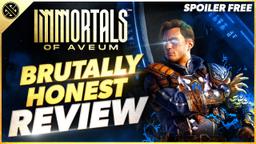Atomic Heart
Written by - Livid
Updated: June 21, 2023
|
Posted: February 20, 2023

It is incredibly hard to believe Atomic Heart is the very first game from Mundfish. They’re a Cyprus based game development studio with over 130 creatives across 10 countries, and frankly, the diversity of talent seems to have paid off. The level of quality that oozes from this ambitious project is nothing short of impressive and it’s not often we are so upfront about this sort of thing when it comes to our reviews.
WHAT THE HECK HAPPENED?
The game is set in an alternate, retro-future version of the 1950s USSR. Professor Sechenov, a brilliant scientist, has invented an omnipotent substance known as the ‘Polymer,’ a fringe technology that aimed to power the technology of tomorrow. As a result, the Soviet Union was propelled to new heights in science, robotics, and AI. This resulted in an explosive economic growth that established the USSR as the leading global power, allowing the country to quickly recover, and flourish, after World War II.
Sechenov then proceeds to announce the upcoming launch of a polymer-powered neural network, known as “The Collective,” that aims to allow people to control robots simply with their minds, and giving humanity the ability to instantly access the world’s knowledge on demand.
Fast forward to today, our character and protege to Sechenov, arrives just days before this grand unveiling where an incident happens at facility no. 3826. An even that sends robots and various top-secret experiments into a killing frenzy. Your job is to find out what exactly went wrong.
Throughout your investigation, you’re paired with a talking, polymeric glove that provides you with near superhuman-like abilities. such as the ability to cast chain lightning, freeze enemies at will, and even invoke telekinetic powers to manipulate enemies and environmental obstacles alike.
After society as we know it comes crumbling down, you’re put on your heels, heading deep underground into facility no. 3826 to find out what exactly is happening. You’ll encounter puzzles, lengthy combat sections, as well as both elite and boss encounters that will test your constantly evolving combat chops.
AN OPEN(ISH) WORLD
I’m sure a lot of players are wondering if Atomic Heart is open world. The short answer; Kind of. There is a sprawling world map littered with various points of interest and enemies to fight. There are even hidden dungeons called polygons, or test rooms, that offer unique encounters and interesting rewards outside of the main story loop.
The game, however, has a very clear and specific plan for you. Heading to massive underground facilities, one after another, makes the open world act more like a container for these larger set pieces. Now will taking your time in the open world between core missions help you beef up your weapons and skills? Of course, but you can also just b-line from point to point and rarely miss anything of note.

The open world does however function as a place to really go buck-wild with your weapons and abilities, since destroying anything will see repair bots gradually swarm the location, restoring whatever you ended up killing. It’s a clever way to keep the world full of combat encounters, while also contributing to the overwhelming feeling of just how awful this whole situation has become. It makes the tide of killer robots feel unstoppable.
Fans of both the BioShock and Fallout series will feel right at home here, and after years of no game filling that void, Atomic Heart manages to capture that same essence, but in a completely new way. Everywhere you go, and everything you do in the world will have you not only questioning what is really going on, but also gives you that uneasy vibe of always needing to look over your shoulder or take a corner slowly, something I haven’t really felt since BioShock.
Atomic Heart is all about pacing and planning. Do you have the right set of skills for the next puzzle? How about the right weapons for the enemies ahead? Is your inventory even prepared for the next string of potential encounters ahead? You’ll find yourself asking all these questions, and it’s a huge part of this game. You must make choices with a limited inventory system that dictates just how many weapons you bring, how much ammo you have before you run out, and even how much health you can restore before you’re one bad dodge results death.
On the highest difficulty, Armageddon, robots will nearly one-shot you, and your reaction time and preparation will absolutely be put to the test. You will die a lot and you will need to plan exactly how you are going to tackle each encounter. Even down to picking your save location, which are physical points throughout the world you need to interact with. Getting stuck in an encounter can become a very real thing, as it happened to me multiple times because of poor resource use in a panic. Those 4 shotgun shots I had left had to be used in just the right moment to secure the kills I needed to progress, and let me tell you, these fights can be a real pain.
COMBAT
Combat is a methodical process. You can’t block attacks, at least, not without equipping a very specific skill. Instead, dodging, evading, and utilizing the environment to avoid enemy attacks is the focus.
Dodging is a limited resource on a short cooldown, and things like i-frames and additional dodge charges are all things you need to invest upgrades into. This means you’ll need to encounter enemies enough times until you really learn their attack patterns, very similar to a souls game.
The enemies have both non-telegraphed and blatantly telegraphed attacks, the later for good reason, as these can not only knock you down, but also deal massive damage, often one-shotting you on the hardest difficulty.
There’s also an energy system to manage. By engaging in melee, each strike will see you accumulate energy. Ranged weapons that utilize this resource, can then consume it to dish out their attacks. Mixing melee and energy using weapons in combat, can effectively ensure you always have a way to deal with a threat at range when you are otherwise out of ammo.
Finally, through your ability to scan the environment and enemies alike, you’ll be able to identify an opponent’s resistances and weaknesses, which directly influence how you can approach them. It’s honestly one of the most fluid and rewarding combat systems we’ve experienced in a game like this to date, and that’s saying something.
one of the most fluid and rewarding combat systems we’ve experienced in a game
ENEMIES
Enemies in Atomic Heart are easily one of the game’s highlights. The sheer level of pathing and combat animation that went into every single enemy in this game is alone, impressive.

Lab Tecs are probably the most plentiful enemies you’ll encounter in Atomic Heart. Think of humanoids with an awful mustache. These are incredibly aggressive the moment you alert them, often sprinting directly at you and attempting to dropkick you into tomorrow. They have a host of melee combinations at their disposal, and when in a group, will strategically try and get around you to hit you from different angles. They even intelligently path through the environment, even vertically, to get to you whatever the cost.
Then there are Laborers, small but plentiful in the world, previously relegated to tasks like refining wood and being part of emergency response teams to cut open vehicles with their large, articulated blades. Just like the lab tecs, these will also get up in your face, but often rev up their saw blades to launch themselves at you at extremely high speeds. They can even launch their blades at you, resulting in them fleeing momentarily to replenish their blades.
Finally, Engineers. Not all enemies start out hostile, these being a prime example. You can choose to forgo engaging them, or take them on for their valuable parts, crafting components you can salvage from every enemy you best in combat. Engineers quickly switch from rather jolly robots, to aggressive, sporadic attacking monstrosities. If you aggro one of these, be ready for a fight, and these are still a relatively early game enemy.
While not a complete list at all, these are the most common. But don’t worry, there are plenty of surprises for you to stumble on to.
WEAPONS
To tackle the numerous threats ahead of you, you’ll need to craft any number of the 20 unique weapon blueprints you’ll come across in the story.
You’ll start out with an axe, called the Swede, as your primary method of dealing with threats. Through various upgrades, you can increase its damage, alter its special attack entirely, make it more effective against specific enemy types, and even unlock the ability to slot cartridges; allowing you to infuse your weapon’s attacks with specific elements.
Eventually, you’ll unlock progressively bigger and badder weapons, from the tiny electro side arm, that taps into your glove’s energy system, to the Fat Boy that I’m sure any heavy weapon enthusiast will love. You even have the KS-23, your classic tech infused shotgun that has one of the most satisfying kick and feedback loops I’ve experienced with a shotgun in a video game.

Through the upgrade system, all weapons can easily carry you throughout the entire game. It’s truly about picking what you love to use and being prepared, rather than using what’s best, and that’s a huge testament to the stellar weapon design.
INVENTORY
I think it’s also important we briefly revisit and expand up the inventory and crafting systems, specifically in regard to the ammo economy. Atomic Heart chooses to employ a classic grid-based inventory system like many older RPGs. Everything takes up a fixed amount of space such as weapons, ammo, and even the healing canisters.
All ranged weapons of the kinetic variety consume ammo, and this is the sort of thing that balances their strength. Ammo in Atomic Heart isn’t exactly scarce, but it’s not something you can just reliably find as you need it. Because of that, you need to plan your inventory wisely, even going so far as to entirely fill yourself up so that you aren’t trying to rely on random world loot to give you those few extra shots you’ll need to finish the next encounter.
Crafting components, consumables, and even ammo of all varieties are scattered through various containers in the world. Anything you pick up and loot in the world will first look for space in your inventory, before being sent to your storage.

You’ll need to plan out the weapons you’ll take, how much ammo of each to bring, and make sure you leave room to pack canister buffs and healing pods. The great thing about the loot in the game, is that literally nothing goes to waste. It all can be disassembled for core crafting materials depending on the item. Finding ammo you don’t ever use? Salvage it. Getting healing packs that are below your current combat tier? Salvage them. Regretting a weapon investment? Salvage it for your materials back.
SKILLS AND ABILITIES
Finally, lets take a look at skills. You’ll have access to 7 full skill trees, 5 of which are active, while the other 2 are passives. 94 skill nodes in total and thankfully, a good portion of these alter your gameplay.
The active ones will give you access to a variety of things like chain lightning via shock tree or the ability to mass freeze your enemies with frostbite. Fancy a bit of control? Look no further than mass telekinesis. You can even employ fire or augment other skills by coating enemies in polymer via polymeric jet. And for a defensive boost, there’s a polymeric shield that can be deployed.
As far as passives go, you can gain access to additional dodge charges, gain invulnerability frames, boost your health, increase your energy replenishment speed, and a whole lot more.
Regardless of what you choose to invest in, you’ll only be able to slot 2 active abilities, which is why those elemental canisters I mentioned earlier for your weapons can be so important to cover a damage type you’re missing.

Thankfully, this is one of the least restrictive systems I’ve experienced in an RPG, allowing you to entirely refund your skills and retrieve all the polymers you’ve spent on skills without any penalty. This enables free exploration into which skill branch works best for you. Regardless of what you choose to invest in, we found every single skill branch to be a blast to use, especially when weaved into combat between your melee and ranged offerings.
PUZZLES AND EXPERIENCES
Puzzles and minor activities populate the environment between all the combat encounters. Every major facility that you’ll go through will feature a set of core puzzle mechanics that you’ll tackle from encounter to encounter.
These can be as simple as utilizing your telekinesis to move platforms to reach switches and doors, or moving cryo balls through tubes to cool overheating furnaces. Or it can be as complex as manipulating magnetic fields to radically transform the platforming space, unlocking new corridors and even hidden materials.
And let’s not forget lockpicking, yes, it’s so good it deserves to be highlighted. Never in our years of gaming did we think we’d be praising a lockpicking system. We thought it was already perfected, but here comes the Atomic Heart devs saying “nah, let’s make this more fun and interactive.”

Locks on doors can feature any number of puzzles, like snapping your fingers in alternating sequences to trigger locking mechanisms, to re-arranging colored dots to perfectly align when rotated. The harder the locks are, the more of these puzzles get added in sequence. It’s brilliant and I never found myself getting tired of trying to pick that next lock.
EPIC BOSS BATTLES
Simply put, these fights are incredibly well paced and see you leaning even more into timing your dodges and attacks just right. Even the animation and overall performance of the enemies in these fights is just so over the top, that I would sometimes get distracted appreciating just how elaborate their moves were. It’s something I haven’t experienced in any other game besides Fromsoft titles.
Depending on the difficulty that we mentioned earlier, these will be hard checks of your combat knowledge and patience. It’s just another positive tick in Atomic Hearts already impressive resume.
PERFORMANCE
Now, we wouldn’t be doing this review justice if we didn’t mention the performance issues we experienced during our time with the game.
Here were the specs of the machine we played on for this review:
- Processor: AMD Ryzen 9 5950x
- Graphics: Radeon 6800XT
- Memory 32GB
- Storage: NVMe drive
Upon launching the game, the shader cache had to be compiled, something we’ve been seeing progress bars for more and more recently with games due to the sheer amount of fidelity present, and Atomic Heart is certainly included, as the game looks fantastic.
During that time, and sometimes subsequent times launching the game, we’d get horrible, horrible frame stuttering and lag until it was clear those shaders loaded, only a few times however did we even see a progress bar.
We thought that was the end of it, but in various instances during the game, we’d experience large frame drops in what we can only assume was due to the game loading in the open world whenever leaving a building or underground facility, as there are no loading screens in Atomic Heart.
We had to go so far as to turn our game resolution down to 1920×1080 to get performance to stabilize in multiple situations, especially in fights with numerous enemies engaging us at once. I’m hoping this is addressed in either a day 1 patch or in a future optimization pass, because from what I’ve heard, next gen console versions seem to be more stable than the PC build, a running theme these days.
Performance issues aside, I didn’t experience a single bug in my entire time playing this game, and for something of this fidelity and depth. And that is dang impressive.
CONCLUSION
If you haven’t guessed by now, my verdict is that Atomic Heart is definitely worth your time, especially if they get these performance related issues sorted out. Between the main story, side quests, and depending on how often you get sidetracked, you could easily clock in 40+ hours to this title.






